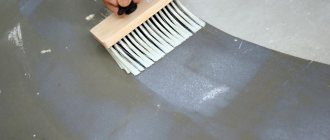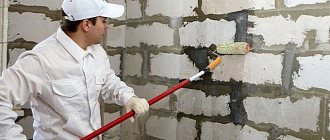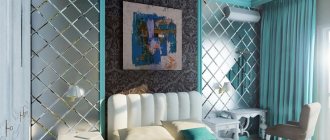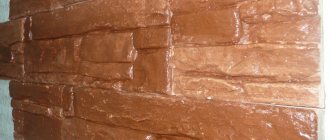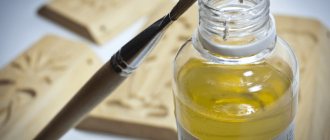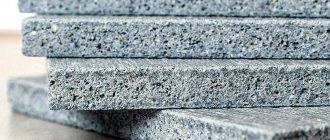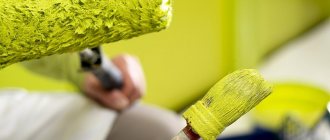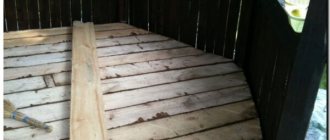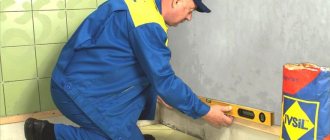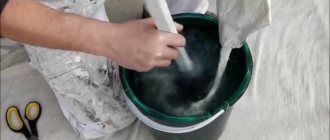Home |Construction |Moisture impregnation for concrete
Date: May 23, 2017
Comments: 2
Concrete used in the construction of buildings has many advantages. However, the technologically advanced and inexpensive material, which has increased strength, has a significant drawback - its porous structure. This feature limits the service life of the monolith, which needs reliable protection. To protect concrete products and improve technical and operational characteristics, water impregnation is used for concrete.
In industrial structures, as well as when performing repair work in residential premises, concrete additives are used for waterproofing. They protect the array from moisture penetration, while maintaining its properties and strength characteristics.
Such additives can be added when making concrete with your own hands. However, concrete impregnation is more effective and economically feasible. Let's take a closer look at what waterproofing is and how it is produced, and also decide which composition is best to use.
One of the most common methods of protection can be considered the advance creation of a moisture-resistant concrete product or structure (primary protection)
The need for waterproofing
Protecting the concrete mass from moisture penetration is the main task during the construction and operation of structures. Waterproofing protects the monolith from negative factors:
- Penetration deep into a body of water, which when frozen causes destruction.
- Absorption of aggressive substances (acid solutions, alkaline compounds, salts) contained in water.
Impregnation of concrete against water is necessary. It eliminates the destructive effects of moisture penetrating both through direct contact of the surface with water and during high air humidity.
Concrete impregnation is a liquid composition that contains adhesive components that form a waterproof layer. The presence of microscopic pores on the surface of the concrete mass is the cause of the following disadvantages of reinforced concrete products:
- reduced hydrophobicity;
- insufficient strength.
Using a moisture-resistant composition, you can easily transform the cellular structure of the array into a waterproof monolith. The need for this arises during the construction of monolithic structures, the construction of load-bearing walls, and the construction of foundations of buildings that are actively in contact with water.
Penetrating concrete waterproofing is a convenient way to protect concrete structures from moisture
Waterproofing is carried out for the purpose of:
- Preventing chemicals and moisture from entering deep into the array.
- Increasing the strength of the base.
- Increasing the wear resistance of concrete screed.
- Improving the presentation of the floor.
- Upgrades of heavily used structures.
- Sealing the base for dust removal.
- Increasing the service life of reinforced concrete structures
conclusions
When choosing a concrete surface treatment method, they are guided by the requirements for surface texture and tensile strength of the base (no more than 1.5 N/mm2). In one case, priority is given to chemical treatment, in the second – to grinding or sandblasting, etc.
It is necessary to understand that such an impact can lead to cracking of concrete, which affects adhesion to new layers and the quality of subsequent work.
| Processing method | Risk of cracking |
| Mechanical | Low to high |
| Sandblasting | Low |
| Shot blasting | Low |
| High pressure devices | Low |
| Chemical | Low |
| Thermal | Average |
If we talk about the choice of material for surface treatment, the main guideline should be the operating conditions of the structure. Liquid glass can be used as an economical waterproofing material. Polysiloxane, polyurethane, silicone, vinyl chloride paints work well on the external surfaces of concrete and reinforced concrete structures.
The video shows how to treat concrete surfaces:
Impregnation for concrete against water - scope of application
The moisture-resistant composition is used for treating building foundations, structural elements, external and internal walls, as well as concrete floors during the improvement and construction of the following objects:
- car parking;
- halls of shopping malls;
- exhibition centers;
- automobile service enterprises;
- car washes;
- workshops of manufacturing enterprises;
- residential and administrative buildings;
- premises of livestock enterprises.
The type of primer mixture is selected individually depending on the characteristics of the surface being treated and the desired effect.
Penetrating waterproofing is a system for protecting concrete from water and aggressive environments
Why is it needed?
According to SNiP 2.03.13-88, a concrete floor needs to be protected from the effects of wastewater, capillary action of moisture and acids contained in the soil.
The main function of waterproofing is to protect house structures from the harmful effects of moisture. Concrete has a fairly high waterproof rating, but under the influence of constant sources of excessive humidity, the material becomes less durable and is susceptible to destruction. Therefore, to prevent such troubles, it is necessary to waterproof the concrete floor from the inside and outside.
Classification
Impregnation for concrete against water is classified depending on the chemical composition:
- Soils of organic origin.
- Mixtures based on inorganic modifiers.
The basis of organic primers are compositions containing:
- epoxy resins;
- polyurethane additives;
- acrylic filler.
Their effectiveness is ensured by the binding component, which fills the concrete pores and forms a moisture-resistant layer. Organic primer removes dust and increases the strength characteristics of the base.
Compositions based on inorganic additives, such as impregnations with the addition of silicates, act completely differently. The modifier is not absorbed by the concrete mass, but interacts with external compounds at the molecular level. As a result of the chemical reaction, the array becomes more durable, a waterproof layer is formed, which promotes dust removal.
The most effective surface waterproofing agent is considered to be a water repellent.
Restoration of road surfaces
It is also worth mentioning how you can extend the life of a concrete or asphalt concrete road surface. In the process of its arrangement, the classical processing technique is usually used - leveling using beacons and compacting with vibration installations. In some cases, a grooved texture is also applied using special brushes.
Application of strengthening emulsion
But the surface treatment of asphalt concrete pavement, performed to compensate for wear, involves the following algorithm:
- We lay a layer of bitumen emulsion on the canvas.
- We pour granite crushed stone into the thickness of the liquid material. It is considered optimal to use a fraction of 5-10 mm with a cubic structure.
- We roll the material with pneumatic rollers, and then leave it until the emulsion is completely polymerized.
In principle, the result is not concrete at all, but such a coating can easily withstand operational loads for a long time.
Moisture-resistant soil - varieties
Additives to concrete for waterproofing differ in their purpose:
- Primers that increase the strength of the base. They are based on silicate compounds. The composition, being deeply absorbed into the massif, changes its structure. Increased wear resistance is ensured by the adhesion of the primer mixture to the base, which increases the wear resistance of the surface and removes dust from it. Detachment of a reinforcing coating that penetrates deeply into the structure of an array is almost impossible. The floor of the room, supporting structures, ceiling and walls are gradually covered with the primer mixture. The use of compositions based on lithium silicate increases the resistance of the surface to abrasive loads, high humidity, and impedes the formation of dust. The treated surfaces can be used 1-2 hours after applying the primer.
- Water-repellent compounds.
They contain water-repellent additives that penetrate into pores and deep cracks. Along with protection against water penetration, the composition protects against mold, microorganisms, cracking, ultraviolet exposure and salt stains. External treatment of the concrete surface increases the thermal insulation characteristics and resistance of reinforced concrete to negative temperatures. Water repellent for concrete provides effective protection indoors. However, using a water repellent for concrete, it is impossible to reliably protect the base of the building from absorbing moisture from the soil. The market offers two-component impregnations that provide high waterproofing efficiency during the construction of hydraulic structures. No additional mastics or adhesives are required for application, no need to install fastening equipment - Dust removal solutions. Impregnation of concrete for dust removal is in demand during the construction of various objects. Before starting treatment with polymer primer, dust should be removed from the surface of the floor, walls or ceiling. The soil, which impedes the formation of dust, penetrates 4–6 mm into the base. It reliably protects it from destruction under mechanical stress and the influence of acidic and alkaline environments. The composition increases the wear resistance of the base and increases its service life. The absence of the need for special care is one of the main advantages of the treated surface.
- Coloring mixtures for coating. The use of conventional paints and varnishes does not give the desired effect. The coating gradually peels off and cracks during use. Such a surface is short-lived and requires periodic updating. The depth of penetration into the concrete mass of colored impregnations is about three millimeters, which ensures the preservation of the color range over a long period, regardless of the intensity of the abrasive effect. After applying the coloring mixture, the application of a water-repellent primer is required.
Tips for choosing concrete impregnation
When choosing impregnation, pay attention to the following points:
- mixtures for chemical hardening on a silicate basis make it possible to ensure effective dust removal at minimal cost, as well as intensive use of the floor covering;
- It is advisable to use polymer compositions based on epoxy fillers when the coating is exposed to aggressive environments and in order to ensure the presentation of the base.
When choosing a material for surface waterproofing, you should take into account its operating conditions and the features of the concrete structure
Features of use
Hydrophobic coatings intended for concrete are applied in two ways:
- Added to the solution during its preparation. The composition is distributed evenly and binds with other elements. The output is moisture-resistant and durable hydrophobic concrete.
- The surface of ready-made concrete structures is covered with a roller or brush. It is absorbed into concrete, passing through the capillaries of living stone. Forms a durable moisture-proof film. It is used before gesso walls, wallpapering, or before applying any other decorative coating.
Before applying to the base, it is necessary to remove dust and grease from the concrete wall and dry thoroughly. Then the hydrophobic impregnation is applied with a roller or brush. After applying the first layer, you need to let the wall dry. It is allowed to begin applying decorative materials to the surface of the structure only the next day.
General requirements for waterproofing and strengthening
When performing work, pay attention to the following points:
- The compositions are applied to a pre-dried base.
- Recommended room temperature for work is 20–25 °C.
- The surface to be treated must have a temperature of more than 10 °C.
- It is advisable to abrasively grout the base before waterproofing.
- Peeling and cracking on the base are not allowed.
- The use of personal protective equipment is mandatory.
Installation of self-leveling polymer floor
To install a self-leveling polymer floor, it is necessary to follow the technology and sequence of actions.
The main stages of laying a polymer self-leveling floor:
- Preparation of the base - cleaning, filling minor defects, leveling, removing dust and dirt, grinding the surface. If the floor is applied to a fresh coating, you must wait 28 days after pouring.
- base - you can add fine quartz sand to it, which will improve adhesion. When the primer is applied, wait a day and remove the remaining sand with a vacuum cleaner.
- Arrangement of the base layer of the self-leveling floor - the prepared solution is simply poured onto the surface, a squeegee is used to distribute it, and air bubbles are removed with a needle roller. It is best to perform work at an ambient temperature ranging from 5 to 25 degrees Celsius.
- When the base layer has dried, a thin finishing layer of polymer is poured. There are mixtures that do not require this stage.
Concrete impregnation - application technology
Carry out self-hardening of the surface as follows:
- Prepare the primer mixture and working tools.
- Prepare the surface by removing loose layers and sanding the base.
- Mix the required volume of the mixture, following the manufacturer's recommendations.
- Cover the base with an even layer of impregnation.
- Apply a second coat after the previous one has completely dried.
The waterproof layer will dry in 10–16 hours.
